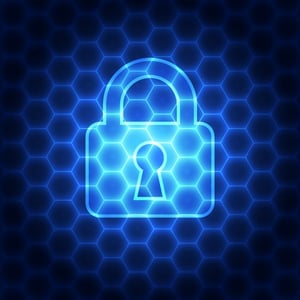Share this
Know Your Wireless Network Basics: Network Security
by Robert McNicholas on August 29, 2017
 Networks are all around us, but do we know how they work? In this series, we’ll look at the basics of computer networking, from hardware components to security practices. This is the fourth post in the series. To read the preceding post, click here.
Networks are all around us, but do we know how they work? In this series, we’ll look at the basics of computer networking, from hardware components to security practices. This is the fourth post in the series. To read the preceding post, click here.
So now we know how Wi-Fi works, and we know the physical components of a computer network. We know the pros and cons of wireless vs. wired networking.
What’s the next logical question?How do I keep all this stuff secure?
While the information in this post is for everyone, it’s especially good for homes and small businesses that use a Wi-Fi network. Quite frankly, most of the home networks I see are not very secure. I really would recommend that you have a pro, or a knowledgeable friend, set up your Wi-Fi network initially.
That being said, there are some basic changes you can make that will keep your network in much better shape than a straight-from-the-box setup could.
Wireless Network Security Basics
One of the main aspects of network security is controlling access. We’ll get into that a bit more in our next post. Access to wireless networks can be a bit trickier to control. The dude in the parking lot could be hacking into every computer logged onto your network, and no one would realize it because they can’t actually see him.
That, in itself, is scary. So what precautions can you take?
- Secure your network. Don’t leave it open; that’s like refusing to lock the door to a safe. If you’re given an option, choose WPA-2 encryption. It’s the best choice.
- Change from your default Wi-Fi password, and make it a good one. We’re going to be talking a lot about passwords in a couple of weeks, but we’ll just say that your password needs to be strong: a mixture of numbers, symbols, capital letters, and lowercase letters. These are harder to crack than something like password123.
- Change your router passcode. Usually this is printed on a sticker located somewhere on your Wi-Fi router. It will look like a totally random shot at a keyboard: b7md57hg*m. (Yes, I typed that at random.) Change this as well; whoever gets unauthorized control of your router gets total control of your network.
- Activate your firewall. Newer Wi-Fi routers and gateways often come with a built-in firewall. Even if you don’t know what you’re doing, activate it. You can get that knowledgeable friend or expert professional to tweak the settings later. Light protection is better than no protection at all.
- Don’t broadcast your signal. I realize this seems like a contradiction; Wi-Fi is all about broadcasting a signal. But you can actually hide your Wi-Fi signal so that it doesn’t register on devices not already connected to the network. It’s not hard to do, but it does require a slight bit of tinkering. My recommendation is to leave your signal visible until you get all your devices on the network, and then use the router’s settings option to hide the signal.
There are other ways to keep your network secure. They have names like MAC authentication, IDS software, and network monitoring, and they’re not for the absolute beginner. But these steps will give you a leg up over many networks.
And if you need professional advice, you can always call on the pros at Techspert Services.
Share this
- Featured (119)
- Best Practices (75)
- Business (72)
- Small Business (72)
- Security (43)
- Managed Services (34)
- Business Growth (32)
- Technology News (26)
- Google For Work (22)
- it support (15)
- Social Media (13)
- Technology (11)
- Malware (10)
- Google (9)
- News (9)
- Productivity (9)
- Technology Support (8)
- Cloud (6)
- seo (6)
- Backup Storage (5)
- Website (5)
- Communication (4)
- Ransomware (4)
- Research (4)
- Analytics (3)
- Windows (2)
- anti malware (2)
- email (2)
- how to (2)
- laptops (2)
- mobile (2)
- Hubspot (1)
- data recovery (1)
- twitter (1)
- July 2024 (1)
- June 2024 (2)
- May 2024 (2)
- April 2024 (2)
- March 2024 (2)
- November 2022 (3)
- October 2022 (1)
- September 2022 (3)
- August 2022 (3)
- December 2021 (3)
- November 2021 (3)
- October 2021 (1)
- September 2021 (3)
- August 2021 (3)
- July 2021 (1)
- March 2021 (1)
- February 2021 (7)
- January 2021 (1)
- March 2020 (1)
- August 2019 (1)
- April 2019 (4)
- March 2019 (6)
- December 2018 (10)
- November 2018 (10)
- August 2018 (1)
- July 2018 (9)
- June 2018 (4)
- May 2018 (4)
- October 2017 (3)
- September 2017 (6)
- August 2017 (6)
- July 2017 (12)
- June 2017 (12)
- May 2017 (3)
- March 2017 (5)
- February 2017 (2)
- August 2016 (2)
- June 2016 (4)
- January 2016 (1)
- December 2015 (3)
- November 2015 (3)
- October 2015 (3)
- September 2015 (3)
- August 2015 (2)
- July 2015 (4)
- June 2015 (3)
- May 2015 (2)
- April 2015 (1)
- March 2015 (1)
- February 2015 (1)
- January 2015 (2)
- November 2014 (4)
- October 2014 (11)
- September 2014 (5)
- August 2014 (6)
- July 2014 (6)
- June 2014 (8)
- May 2014 (3)
- April 2014 (3)
- March 2014 (2)


